 Hastings District
Council
Hastings District
Council
Civic Administration Building
Lyndon Road East, Hastings
Phone: (06) 871
5000
Fax:
(06) 871 5100
WWW.hastingsdc.govt.nz
Open
A G E N D A
HDC - Māori Joint
Committee MEETING
|
Meeting Date:
|
Wednesday,
22 May 2019
|
|
Time:
|
1.00pm
|
|
Venue:
|
Council
Chamber
Ground Floor
Civic
Administration Building
Lyndon Road
East
Hastings
|
|
Committee Members
|
Chair: Mr Robin Hape
Mayor Sandra Hazlehurst
Councillors Bayden Barber (Deputy
Chair), Eileen Lawson, Henare O’Keefe, Jacoby Poulain and
Geradline Travers
Mr Te Rangihau Gilbert, Ms Tracee Te
Huia, Mrs Evelyn Ratima, Mr Ngaio Tiuka and Vacancy
Kaumatua: Jerry
Hapuku
|
|
Officer
Responsible
|
Pou Ahurea Matua Principal Advisor:
Relationships, Responsiveness and Heritage – Dr James Graham
|
|
Committee
Secretary
|
Carolyn Hunt (Extn 5634)
|
Hastings District Council: Māori Joint Committee –
Terms of Reference
This Committee is established between the Hastings
District Council and Māori.
Context
· The Joint Committee has
been established by the Council as a deliberate step taken to assist in the
development of sustainable relationships with Māori. Further it is
intended the Council meet the intent and spirit of the Council’s
obligations set out in the legislation more particularly the obligations of the
Local Government Act 2002:-
·
− towards establishing and
maintaining processes that provide opportunities for Māori to contribute
to the decision processes of the Council and
− fostering the development
of Māori capacity to contribute to those processes and
− the provision of
information to assist Māori contribution to Council’s activities.
· The Council wishes the
Joint Committee to reflect a spirit of partnership between the Council and the
community and to contribute effectively to the Council’s
activities. To enable this to occur the Fields of Activity and Delegated
Powers are framed with the widest scope possible.
· The Council wishes the
Joint Committee to assist it with the development of an integrated policy
framework (based on Treaty of Waitangi Principles) for the Council aimed at
delivering effective governance, engagement and service delivery for
Council’s Māori Communities.
Fields of
Activity
· To provide policy advice
with respect to the District Plan, regarding provisions for Wāhi Tapu,
Papakainga, and where relevant to tangata whenua, any other amendments to the
Plan.
· To provide input to the
LTP and Annual Plan with particular reference to those issues of
importance to Māori from with the District.
· To host Council hui a hapu
events held twice a year.
· To provide insight into
Māori and other strategic community issues with particular reference to
the Long Term Plan, the effectiveness of the District Plan and the delivery of
the Annual Plan.
· To consider and recommend
Māori capacity building initiatives within budget and resource constraints
of the Council.
· To assist the Council as appropriate
in conducting and maintaining effective, good faith working relationships with
the Māori community including advice on governance arrangements.
· To make decisions as to
the allocation of Marae Development Fund grants within the allocated budget.
· To assist the Council with
the development of an integrated policy framework and work programme to enable
effective governance, engagement and service delivery for Council’s
Māori Communities.
Membership (12
Members)
The Mayor.
5 Councillors
appointed by the Council.
6 members from
Tangata Whenua to be appointed by the Council and Kaumatua, taking into account
the “post settlement environment” and Matāwaka.
Election of
Chairman and Deputy Chairman:
Chairman –
to be elected at the first meeting of the Committee at the beginning of each
triennium; and from among the appointed Tangata Whenua members of the
committee.
Deputy Chair
– to be elected at the first meeting of the Committee at the beginning of
each triennium from among the elected members of the committee.
Quorum – at least three Councillor Members
and three Tangata Whenua Appointees.
Delegated
Powers
Authority to
exercise all Council powers, functions and authorities in relation to the
matters detailed in the Fields of Activity such as to enable recommendations to
the Council on those matters.
Authority to make
decisions on the allocation of Marae Development Fund grants within the
allocated budget.
Authority to
develop procedures and protocols that assist the Committee in its operation,
provided that such procedures and protocols meet the statutory requirements of
the Local Government Act 2002, the Local Government Official Information and
Meetings Act 1987 and Council’s Standing Orders.
The Chairman shall
not have a casting vote.
Note: The Terms of
reference for the Hasting District Council: Māori Joint Committee shall be
subject to review by the Joint Committee at its first meeting following each
local government triennial election.
HASTINGS DISTRICT COUNCIL
HDC - Māori Joint
Committee MEETING
Wednesday, 22 May 2019
|
VENUE:
|
Council Chamber
Ground Floor
Civic Administration Building
Lyndon Road East
Hastings
|
|
TIME:
|
1.00pm
|
|
A G E N D A
|
1. Apologies
At the close of the agenda no
apologies had been received.
At the close of the agenda no
requests for leave of absence had been received.
2. Conflict
of Interest
Members need to be vigilant to
stand aside from decision-making when a conflict arises between their role as a
Member of the Council and any private or other external interest they might
have. This note is provided as a reminder to Members to scan the agenda
and assess their own private interests and identify where they may have a
pecuniary or other conflict of interest, or where there may be perceptions of
conflict of interest.
If a Member feels they do
have a conflict of interest, they should publicly declare that at the start of
the relevant item of business and withdraw from participating in the
meeting. If a Member thinks they may have a conflict of interest,
they can seek advice from the General Counsel or the Democratic Support Manager
(preferably before the meeting).
It is noted that while Members can
seek advice and discuss these matters, the final decision as to whether a
conflict exists rests with the member.
3. Confirmation
of Minutes
Minutes of the HDC - Maori Joint
Committee Meeting held Wednesday 6 March 2019. 1
4. Forum Item - 3Waters
Review Update 9
5. Te Kura Nui - The
Māori Cultural Responsiveness Framework 21
6. Activities update 37
7. Māori Joint
Committee Tangata Whenua [Replacement] Membership 59
8. Greater
Heretaunga/Ahuriri Freshwater Catchments -TANK Process and Draft Plan Change 65
9. Additional
Business Items
10. Extraordinary
Business Items
 Hastings District
Council
Hastings District
Council
Civic Administration Building
Lyndon Road East, Hastings 4156
Phone:
(06) 871 5000
Fax: (06) 871 5100
www.hastingsdc.govt.nz
OPEN
M I N U T E S
HDC - Māori Joint
Committee
|
Meeting
Date:
|
Wednesday, 6 March 2019
|
Minutes
of a Meeting of the HDC - Māori Joint
Committee
held
on 6 March 2019 at 1.00pm
Table of Contents
Item Page No.
1. APOLOGIES 1
2. Conflicts
of Interest 1
3. Confirmation
of Minutes 2
4. FORUM
ITEM : Te Awa o Te Atua Reserve 2
5. Forum
Item - 3Waters Review Update 2
12. Additional
Business Item 3
12A. Review of Māori
Participation in Council Decision Making 3
6. Resignation
Shayne Walker 4
7. Omarunui
Landfill development planning 4
8. Treaty
of Waitangi Workshops 5
9. Te
Matā o Rongokako Track Update 5
10. Te Ara
Kahikatea - Whakatū Arterial Name 6
11. Te Reo
Māori Level One and level Two Courses 6
13. Extraordinary
Business Items 7
HASTINGS DISTRICT COUNCIL
MINUTES
OF A MEETING OF THE HDC
- Māori Joint Committee
HELD
IN THE Council Chamber,
Ground Floor, Civic Administration Building, Lyndon Road East, Hastings ON
Wednesday, 6 March 2019 AT 1.00pm
Present: Chair: Mr
Robin Hape
Councillors
Travers, Barber, (Deputy Chair) and Poulain
Messrs
Te Rangihau Gilbert, Ms Tracee Te Huia, Mrs Evelyn Ratima and Mr Ngaio Tiuka
Kaumatua: Jerry Hapuku
ALSO Present: Chief Executive (Mr Nigel Bickle)
Pou
Ahurea Matua Principal Advisor: Relationships, Responsiveness and Heritage
– (Dr James Graham)
Group
Manager: Asset Manager (Mr C Thew)
Group
Manager: Planning and Regulatory (Mr J O’Shaughnessy)
Manager:
Democracy and Governance Services (Mrs J Evans)
Committee
Secretary (Mrs C Hunt)
AS REQUIRED: Te Muri Whaanga (Item 4)
Troy Brockbank, WPS Opus (Item 5)
Toni
Goodlass, Hawke’s Bay LASS (Item 5)
Peter
Paku (HDC:Tangata Whenua Wastewater Committee Member) (Item 5)
Kaumātua Jerry Hapuku gave the
opening Karakia.
1. APOLOGIES
|
|
Councillor
Barber/Councillor Travers
That
apologies for absence from Shayne Walker, Mayor Hazlehurst and Councillors
Lawson and O’Keefe be accepted.
CARRIED
|
|
|
An apology from Tania Kupa-Huata
HDC:Tangata Whenua Wastewater Committee Member was noted for Item 5.
|
2. Conflicts
of Interest
There were no declarations
of conflicts of interest.
3. Confirmation
of Minutes
|
|
Mr
Hape/Councillor Travers
That the
minutes of the HDC - Māori Joint Committee Meeting held
Wednesday 28 November 2018 be confirmed as a true and correct record and be
adopted.
CARRIED
|
|
4.
|
FORUM ITEM : Te Awa o
Te Atua Reserve
(Document 19/207)
|
|
|
Te Muri Whaanga presented the booklet
“Ngā Tikanga o Te Harakeke (Preparation and harvesting of Flax)
which contained contacts and tikanga protocols and a resource for Ngāti
Kahungunu weavers.
|
|
|
Ms Te Huia/Mrs Ratima
A) That
the report of the Pou Ahurea Advisor: Responsiveness, Relationships
& Heritage titled “FORUM ITEM : Te Awa o Te Atua Reserve”
dated 6/03/2019 be received.
With
the reasons for this decision being that the objective of the decision will
contribute to meeting the current and future needs of communities for (good
quality local infrastructure)
· The Kaupapa is to retain indigenous mātauranga of harakeke,
ensuring the product is well cared for and correct protocols are protected
are maintained. If the protocols are kept a plentiful supply of
harakeke for present and future weavers will be confirmed.
CARRIED
|
|
Tangata Whenua Members (Evelyn Ratima,
Peter Paku and Tania Kupa-Huata) of the HDC: Tangata Whenua Joint Waste
Committee were invited to the presentation of the 3Waters Review Update.
|
|
5.
|
Forum Item - 3Waters
Review Update
(Document 19/193)
|
|
|
Mr Brockbank
advised that Morrison Low were undertaking the 3Waters Review on behalf of
Hawke’s Bay Local Authority Shared Services (HBLASS) and he had been
engaged from WPS Opus to support Iwi Engagement.
The Government
was reviewing how to improve the management of drinking water, stormwater and
wastewater (3Waters) to better support New Zealand’s prosperity,
health, safety and environment.
Mr Brockbank
displayed a powerpoint presentation (CG-14-4-00084) on the background of
3Waters and the need to have cultural input.
Central
government’s major outcomes:
· Safe, acceptable (taste, colour, smell) and
reliable drinking water
· Better environmental performance for our water
services
· Efficient, sustainable, resilient and
accountable water services
· Achieving these aims in ways our communities
can afford their water bills
Mr Brockbank advised the first approach
for the review was to work with councils, next stage based on feedback how
best take on next engagement with wider communities.
He sought feedback from the Committee on
what was regionally important to Māori and key issues for iwi and
Māori.
Points highlighted included:
·
Partnership – what need as Māori
equity and delivery in community
·
Quality of water – issues around
chlorine
·
Affordability – do not want water
charges for the district.
·
Report on assets and principles shared
·
Terminology – 3 waters infrastructure
needs to be clear.
·
Primary concern around regulation
·
Regional option seems logical
·
No water metering
·
Māori values
·
Māori dimension around water –
resourcing and flowback to iwi and hapū
·
Cannot view Māori aspirations as just
culture
·
Important there is Treaty context within
cultural aspect
·
Each water is a wānanga itself
·
Māori engagement this is default forum
need to reflect on all people manu whenua. The Committee was not the
forum for engaging with Māori, need to make direct contact with groups.
·
Intergenerational wealth – is not money
|
|
|
Ms Te Huia/Councillor Poulain
A) That
the report of the Pou Ahurea Matua - Principal Advisor: Relationships,
Responsiveness and Heritage titled “Forum Item - 3Waters Review
Update” dated 6/03/2019 be received.
CARRIED
|
|
With the agreement of the meeting the
Additional Business Item 12 was taken out of order.
|
|
12.
|
ADDITIONAL BUSINESS
ITEM (Document 19/175)
|
|
12A.
|
Review of Māori
Participation in Council Decision Making
(Document 19/220)
|
|
|
The Manager: Democracy and Governance
Services, Mrs Evans updated the Committee on the outcome of the workshop held
with Council on arrangements for Māori participation in decision making. The HDC: Māori Joint Committee
full Council workshop agreed in principle on the appointment of tangata
whenua members to Council’s standing committees.
Appointments made would be until the
triennial elections in October 2019. Any decision for future
arrangements would be up to the incoming Mayor and Councillors following the
election.
|
|
|
Mr Hape/Councillor Barber
A) That
the report of the Manager: Democracy and Governance Services titled “Review
of Māori Participation in Council Decision Making” dated 6/03/2019
be received.
B) That
the HDC : Māori Joint Committee recommend to Council that it agrees to
the appointments of tangata whenua members, with voting rights to the
Hastings District Council Standing Committees.
C) That
the HDC : Māori Joint Committee recommend to Council that the
following tangata whenua members be appointed to the following Standing
Committees from 28 March 2019:
|
Community
Development
|
Evelyn Ratima
|
|
Finance and
Risk
|
Ngaio Tiuka
|
|
Strategy, Planning and
Partnerships
|
Tracee Te Huia
|
|
Works and
Services
|
Te Rangihau Gilbert
|
D) That the
HDC: Māori Joint Committee review the current Terms of Reference and
membership for the 2019-2022 triennium
With
the reasons for this decision being that the objective of the decision will
contribute to meeting the current and future needs of communities for local
public services in a way that is most cost-effective for households and
business by improving Māori engagement in
the Council’s governance and decision making processes.
CARRIED
|
|
6.
|
Resignation Shayne
Walker
(Document 19/152)
|
|
|
Councillor Barber/Ms Te Huia
A) That
the report of the Pou Ahurea Matua - Principal Advisor: Relationships,
Responsiveness and Heritage titled “Resignation Shayne Walker”
dated 6/03/2019 be received.
B) That
the HDC : Māori Joint Committee accept the resignation of Shayne Walker.
CARRIED
|
|
7.
|
Omarunui Landfill
development planning
(Document 19/152)
|
|
|
The Group Manager: Asset Management, Mr
Thew sought guidance from the Committee on the future
planning and consultation in regards to the development of the Omarunui
landfill.
It was noted that consultation also be
undertaken with Mana Ahuriri and Marae at Waiohiki, Ahuriri, Ōmahu and
Moteo Pā
|
|
|
Mr Tiuka/Councillor Barber
A) That
the report of the Group Manager: Asset Management titled “Omarunui
Landfill development planning” dated 6/03/2019 be
received.
CARRIED
|
|
8.
|
Treaty of Waitangi
Workshops
(Document 19/174)
|
|
|
The Pou Ahurea Matua – Principal Advisor:
Relationships, Responsiveness and Heritage, Dr Graham updated
the Committee on the cultural development programme. A second Treaty of
Waitangi Workshop would be held in May 2019 for Councillors and the
Leadership Team. With a workshop also planned for Council senior or
middle managers.
|
|
|
Ms Te Huia/Mr Gilbert
A) That
the report of the Pou Ahurea Matua - Principal Advisor: Relationships,
Responsiveness and Heritage titled “Treaty of Waitangi Workshops
” dated 6/03/2019 be received for information.
With
the reason for this recommendation being that the objective of the decision
will contribute to meeting the current and future needs of communities and
the staff at Council in a way that ensures that the Treaty of Waitangi is
applied across all facets of Local Government; and,
·
That the objective of the decision will
contribute to effective local decision making and action by, and on behalf of
communities.
CARRIED
|
|
9.
|
Te Matā o
Rongokako Track Update
(Document 19/175)
|
|
|
The Pou Ahurea Matua – Principal Advisor:
Relationships, Responsiveness and Heritage, Dr Graham
advised that 11, 12 and 13 June 2019 had been set for the Hearing. A
tentative timeline (CG-14-14-00088) for the hearing would be circulated to
members.
The Group Manager: Planning and
Regulatory Services advised that the Commissioners appointed to the Hearing
were Rauru Kirikiri and Paul Cooney.
|
|
|
Councillor Barber/Mrs Ratima
A) That
the report of the Pou Ahurea Matua - Principal Advisor: Relationships,
Responsiveness and Heritage titled “Te Matā o Rongokako
Track Update” dated 6/03/2019 be received.
With the
reasons for this decision being that the objective of the decision will
contribute to effective local decision making and action by, and on behalf of
communities, and the decision will contribute to meeting the current and
future needs of communities by:
i) Ensuring that committee is properly informed of the progress to
date on the full track remediation on Te Matā o Rongokako and the
proposed process that will follow.
CARRIED
|
|
10.
|
Te Ara Kahikatea -
Whakatū Arterial Name
(Document 19/176)
|
|
|
The Pou Ahurea Matua –
Principal Advisor: Relationships, Responsiveness and Heritage, Dr Graham updated the Committee on the approved
name of the new arterial route constructed between State Highway 2 North and Pākōwhai
Road, which was officially opened on Saturday February 23 and named Te Ara
Kahikatea.
|
|
|
Ms Te Huia/Councillor O'Keefe
A) That
the report of the Pou Ahurea Matua - Principal Advisor: Relationships,
Responsiveness and Heritage titled “Te Ara Kahikatea -
Whakatū Arterial Name” dated 6/03/2019 be
received.
With the
reasons for this decision being that the objective of the decision will
contribute to good quality local infrastructure in
a way that is most cost-effective for households and business by:
i) Providing
the name Te Ara Kahikatea to this new road clearly resonates with a sense of
place, a sense of history, and the empowerment of the wider community on a
collaborative journey that has linked Council, mana whenua and other key
stakeholders throughout the project including the enablement of both
business’ and households to better access and travel throughout this
area.
CARRIED
|
|
11.
|
Te Reo Māori
Level One and level Two Courses
(Document 19/177)
|
|
|
Ms Te Huia/Mr Gilbert
A) That
the report of the Pou Ahurea Matua - Principal Advisor: Relationships,
Responsiveness and Heritage titled “Te Reo Māori Level One
and level Two Courses” dated 6/03/2019 be received
for information.
With the
reason for this recommendation being that the objective of the decision will
contribute to meeting the current and future needs of communities and the
staff at Council in a way to ensure that te reo Māori is preserved as a
taonga of great value to Aotearoa New Zealand.
CARRIED
|
13. Extraordinary
Business Items
There were no extraordinary business items.
________________________
Karakia:
Te Rangihau Gilbert
The meeting
closed at 4.10pm
Confirmed:
Chairman:
Date:
REPORT TO: HDC
- Māori Joint Committee
MEETING DATE: Wednesday 22 May
2019
FROM: Pou Ahurea Matua - Principal
Advisor: Relationships, Responsiveness and Heritage
Dr
James Graham
SUBJECT: Forum
Item - 3Waters Review Update
1.0 SUMMARY
1.1 The purpose
of this report is to inform and update the Committee on the “3 Waters
Review” through way of an update and presentation by Tony Goodlass on
behalf of HBLASS.
1.2 The presentation
is accompanied by a document (see Attachment 1) that sets out the
following:
· Confirms the key objectives and principles of the review that we
will assess our options against;
· Provides the long list of options reviewed (including examples of
other models for context);
· Confirms the shortlist of options we are reviewing to develop a
preferred recommendation;
· Provides the timeline of the next steps; and,
· Provides the summary of the discussion and themes from the workshops
with Māori committees that need to be incorporated into any new model recommended
(Appendix A of Attachment 1).
1.3 This report
concludes by recommending the information be received.
|
2.0 RECOMMENDATIONS AND REASONS
A) That
the report of the Pou Ahurea Matua - Principal Advisor: Relationships,
Responsiveness and Heritage titled “Forum Item - 3Waters Review
Update” dated 22/05/2019 be received.
|
Attachments:
|
1
|
3-Waters Review Hawke's Bay T/A Māori Committee
Update May 6
|
STR-1-7-19-846
|
|
|
3-Waters Review Hawke's Bay T/A
Māori Committee Update May 6
|
Attachment 1
|










REPORT TO: HDC
- Māori Joint Committee
MEETING DATE: Wednesday 22 May
2019
FROM: Pou Ahurea Advisor: Responsiveness,
Relationships & Heritage
Rosemary
Smith
SUBJECT: Te
Kura Nui - The Māori Cultural Responsiveness Framework
1.0 SUMMARY
1.1 The purpose
of this report is to update the Committee about the Māori Cultural
Responsiveness Framework.
1.2 This update
arises from consideration of future implementation of the Māori Cultural
Framework across the Hastings District Council.
1.3 The Council
is required to give effect to the purpose of local government as prescribed by
Section 10 of the Local Government Act 2002. That purpose is to meet the current
and future needs of communities for good quality local infrastructure, local
public services, and performance of regulatory functions in a way that is most
cost–effective for households and businesses. Good quality means
infrastructure, services and performance that are efficient and effective and
appropriate to present and anticipated future circumstances.
1.4 This report
concludes by recommending the committee accepts this report.
2.0 BACKGROUND
2.1 The
Māori Joint Committee Terms of Reference (resolved at Council meeting 20
April 2017) state that the Māori Joint Committee is to assist with the
development of an integrated policy framework (based on the principles of the
Treaty of Waitangi) for the Council, aimed at delivering effective governance,
engagement and service delivery for Māori within the District.
2.2 The Terms
of Reference state that the Māori Joint committee develops, updates and
recommends to Council a policy framework and work programme, currently called Te
Kura Nui - Māori Responsiveness Framework.
2.3 In 2018,
Council agreed, in conjunction with the development of a te reo Māori
plan, that it review and format the framework to account for changing Council
environments and cultural awareness and development programmes being undertaken.
2.4 The goal
was that Te Kura Nui would be actively used across all Council group services
to inform best practice service delivery, resulting in improved cultural
outcomes and continuous quality improvement. It would also give Council staff
an opportunity to respond to the Treaty of Waitangi in practical, measurable
and meaningful ways within Council settings.
2.5 The format
reported against in 2015 considered four pou – Governance and
Relationships, Culture and Identity, Prosperity and Wellbeing, Resources and
Infrastructure.
2.6 Te Kura Nui
has elements that explain the overarching philosophy that is inherently tied to
the Treaty of Waitangi and to the organisational values of the Hastings
District Council. It links to Te Ara o Tawhaki, the sequential staircase
framework that is utilised by the workforce to develop their respective
cultural responsiveness journeys.
2.7 This report
accounts for development of Te Kura Nui (see attachment one)
3.0 CURRENT
SITUATION
3.1 The
redrafting of Te Kura Nui is in progress. Information and Technology Services,
media / communications, customer services and the Pou Ahurea are currently
working with Information Leadership Group (a Christchurch-based Gold Microsoft
Partner) to re-design Sharepoint Infokete the internal staff noticeboard.
Te Kura Nui, the cultural framework will be positioned on the front page where
the assessment framework can be easily accessed and reported against.
3.2 The
cultural responsiveness implementation framework concept allows for
accessibility and annual active participation.
3.3 The Pou
Ahurea Matua and Pou Ahurea will manage and coordinate the framework process.
3.4 Each group
service will actively participate in the process including: identification and
allocation of responsibilities to actively manage the process within their
service
3.5 Completion
of a service ‘self-assessment’ using the framework every three
years.
3.6 Development
and agreement with the Pou Ahurea team of an action plan within six months of
completing the self-assessment.
3.7 Participate
in training to inform the development and appropriate delivery of the action
plan
3.8 Participation
in a collaborative process of monitoring progress and promoting ongoing
improvement.
3.9 The
relevant Group Services Manager or Management Team approves the configuration
of services that will complete the self-assessment and confirms
responsibilities for doing so.
3.10 Pou Ahurea works with
Quality and Risk and Human Resources and agrees roles and responsibilities for
supporting the completion of the self-assessment and subsequent action plan by
the service.
3.11 Pou Ahurea and Human
Resources agrees roles and responsibilities for action planning, training and
ongoing monitoring and improvement working in collaboration with the identified
services person(s).
3.12 Pou Ahurea works with
the Communications team to prepare an initial communications package that is of
a professional standard.
3.13 Implementation of Te
Kura Nui will be inclusive of the CE’s Office, Economic Growth and
Organisation Improvement, Asset Management, Community Facilities and Programmes
and Planning and Regulatory Services.
4.0 SIGNIFICANCE
AND ENGAGEMENT
4.1 Treaty of
Waitangi principles have come to form integral considerations in the
development of Māori social policy and strategy setting.
4.2 The
principles articulated by the Royal Commission on Social Policy are:
·
Partnership – working together with iwi,
hapū, whānau and Māori communities to develop strategies for
gain across appropriate services
·
Participation – involving Māori at
all levels in decision-making, planning, development and delivery of services
·
Protection – working to ensure
Māori have at least the same level of access to services as non-Māori
and safeguarding Māori cultural concepts, values and practices.
4.3 These
principles form the basis of Te Kura Nui, the Hastings District Council’s
cultural responsiveness framework as policy documentation to support
implementation into practice at all levels of the organisation.
4.4 Key
responsibilities in partnership with the Māori Joint Committee are to
continue to provide advice, direction, guidance and support with respect to
service planning and development. The Framework provides a systemic management
tool to support services to achieve effective Treaty of Waitangi responsiveness
with support and encouragement.
4.5 This
Framework addresses the significance of the matter in terms of the
Council’s Significance and Engagement Policy in terms of Council’s
operations.
|
5.0 RECOMMENDATIONS
AND REASONS
A) That
the report of the Pou Ahurea Advisor: Responsiveness, Relationships
& Heritage titled “Te Kura Nui - The Māori Cultural
Responsiveness Framework” dated 22/05/2019 be
received.
|
Attachments:
|
1
|
Te Kura Nui HDC May 2019
|
CG-14-14-00093
|
|
|
Te Kura Nui HDC May 2019
|
Attachment 1
|

|
Te Kura Nui HDC May 2019
|
Attachment 1
|

|
Te Kura Nui HDC May 2019
|
Attachment 1
|

|
Te Kura Nui HDC May 2019
|
Attachment 1
|

|
Te Kura Nui HDC May 2019
|
Attachment 1
|

|
Te Kura Nui HDC May 2019
|
Attachment 1
|

|
Te Kura Nui HDC May 2019
|
Attachment 1
|

|
Te Kura Nui HDC May 2019
|
Attachment 1
|

|
Te Kura Nui HDC May 2019
|
Attachment 1
|

|
Te Kura Nui HDC May 2019
|
Attachment 1
|

|
Te Kura Nui HDC May 2019
|
Attachment 1
|

REPORT TO: HDC
- Māori Joint Committee
MEETING DATE: Wednesday 22 May
2019
FROM: Pou Ahurea Advisor: Responsiveness,
Relationships & Heritage
Rosemary
Smith
SUBJECT: Activities
update
1.0 SUMMARY
1.1 The purpose
of this report is to update the Committee about continuing project work.
1.2 This report
concludes by recommending the committee accepts this report.
2.0 BACKGROUND
2.1 The Council
decision to accept the Māori Joint Committee’s recommendation for
[Committee] tangata whenua representation on the Council Standing Committees
ratified on March 28th has received a range of responses. These
responses have ranged from negative, ignorant and uninformed letters, texts,
and articles in the Hawke’s Bay Today newspaper, to positive and vibrant
responses from iwi (see attachment one), individuals, and other
territorial authorities. Social media was also a popular medium for endorsing
the decision by Council, although there were those too who vented their
disagreement, and often with comments that again were ill-informed. It is also
heartening to be contacted by other territorial authorities seeking our
guidance and advice on the similar journeys that they are embarking on in order
to increase and sustain Māori participation in local government contexts.
We congratulate the members once again on their elevation to the respective
Standing Committees of Council and thank those who have attended their hui thus
far. Part of the conversation moving forward around this representation now is
the issue of remuneration for additional time of the tangata whenua members
spending extra time on Council business.
2.2 The first
draft of the Council Māori Language Plan has been completed. The Pou
Ahurea has consulted with Te Taura Whiri o Te Reo Māori, Wellington City
Council, Wairoa District Council, Te Kura Whakarauora and Ngāti Kahungunu
Iwi Inc. on its content, design, reo accuracy and format. The plan will
be completed to coincide and be presented with Te Wiki o Te Reo Māori 2019
celebrations in September.
2.3 Te reo
classes – levels one and two – are well underway as they enter into
the final phase for 2019. Level 2 class is slightly advanced as they are
extend pepeha to whakapapa (whakahua pepeha, whakahua whakapapa and whakahua
kōrero mōna anō).
2.4 The aim is
to connect with mana whenua through the land, the environment, prominent places
and people of the area. Level two’s second noho marae is taking
place the weekend of 10 May where HDC tauira (students) will connect with other
EIT-enrolled tauira that together number approximately 150.
2.5 The Waipatu
Community Plan has been drafted after multiple consultation hui with local
residents. A draft action plan was presented to the community on
the 28 April 2019. Work is yet to be finalised and collectively approved
before it can be presented to Council.
2.6 Milestone
One report of the Bridge Pā Long Term Plan has been received from the Mangaroa
Marae Committee. The project team chose a research framework that took
into consideration the tikanga of the research and the need to incorporate
whakapapa, tika, manaakitanga and mana into its design and processes.
2.7 The
methodology would then put at the front the cultural heritage and history of
the community, allowing meaningful recommendations to move the community
towards achieving priorities and its potential. As such, the findings
would inform long term relationships between diverse sectors of Hastings and
Council itself. In saying that, the Bridge Pā plan puts the
voice of the community at front and centre ensuring both Māori (mana
whenua and mātaawaka) and Pākehā (multi-generational, recent
arrivals and visitors) have input into the shape of the research (see
attachment two).
2.8 Recruitment
for staff IronMāori 2019 participants is underway as we look for entrants
to the Kaumatua 3km walk and Quarter IronMāori team events. In 2018,
HDC entered 10 Kaumatua and three teams however, with this early start we are
wanting to improve those numbers. Participants included
Kaikaunihera/Councillors, LMT members and a range of staff from across all
services. Information for those interested has been posted on InfoKete
and will continue to be. The event is held in November so there is plenty
of time to register and support this event with HDC.
2.9 Regular
contact by whānau with Customer Services and Reception often results in
calls and emails to the Pou Ahurea, either as notification of ongoing issues
coming to the front desk or as policy determines the enquiry is passed to
relevant officers.
2.10 Often our whanau are
concerned with the lack of response from HDC staff and feel they are being
marginalised and passed off. The Pou Ahurea has good relationships with
both front desk and call centre staff and is able to reassure whanau this is
not the case.
2.11 Often the issue is to
do with the Māori Land Court, Te Puni Kokiri, or Te Taiwhenua o Heretaunga
which are out of our jurisdiction to advise, however, rates rebates, traffic
infringements, papakainga development or even marae settlement questions are
dealt with. Council has a small number of repeat callers or visitors who
are brought to our attention with their request for intervention.
|
3.0 RECOMMENDATION
That the report of
the Pou Ahurea Advisor: Responsiveness, Relationship and Heritage titled
“Activities Report” dated 28 May 2019 be received.
|
Attachments:
|
1
|
Koha to the world
|
CG-14-14-00091
|
|
|
2
|
Strategies & Development Projects - Arts,
Architecture, Cultural & Heritage - Marae Development - Bridge pā
Community Plan Report
|
STR-1-9-19-90
|
|
|
Koha to the world
|
Attachment 1
|


|
Strategies & Development Projects - Arts,
Architecture, Cultural & Heritage - Marae Development - Bridge pā
Community Plan Report
|
Attachment 2
|









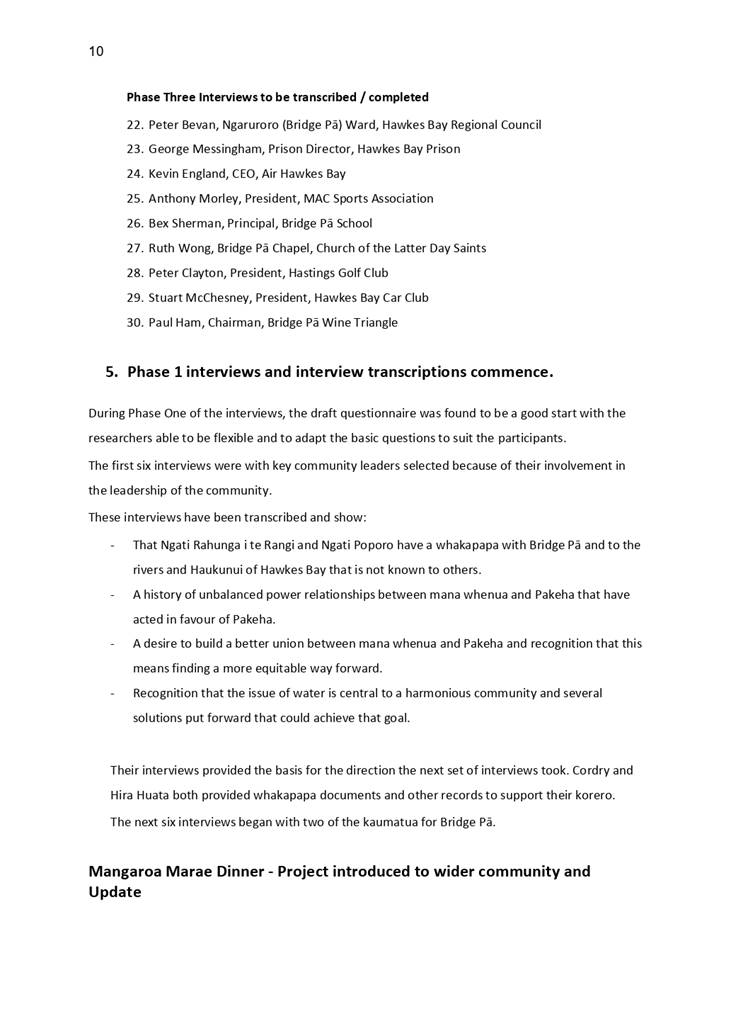

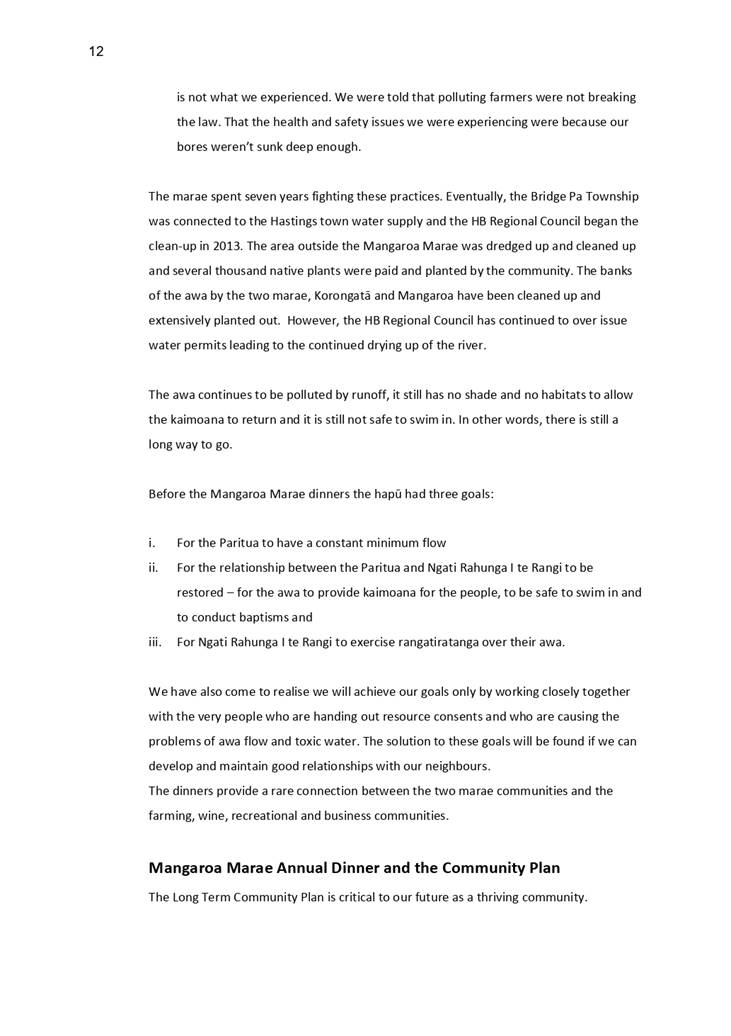

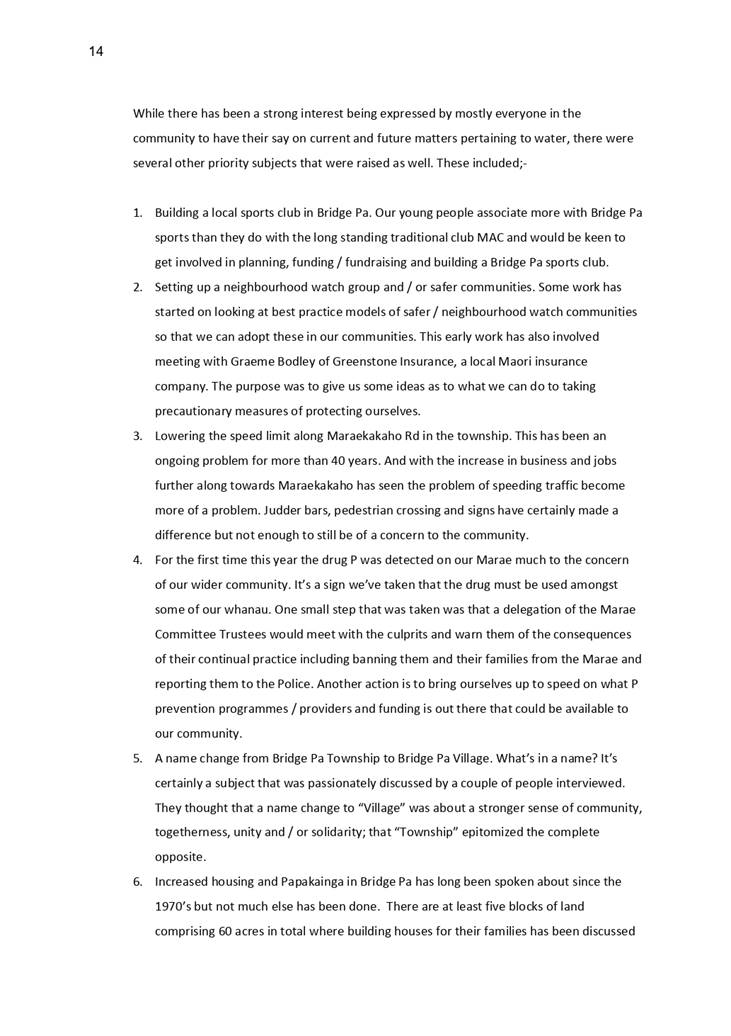

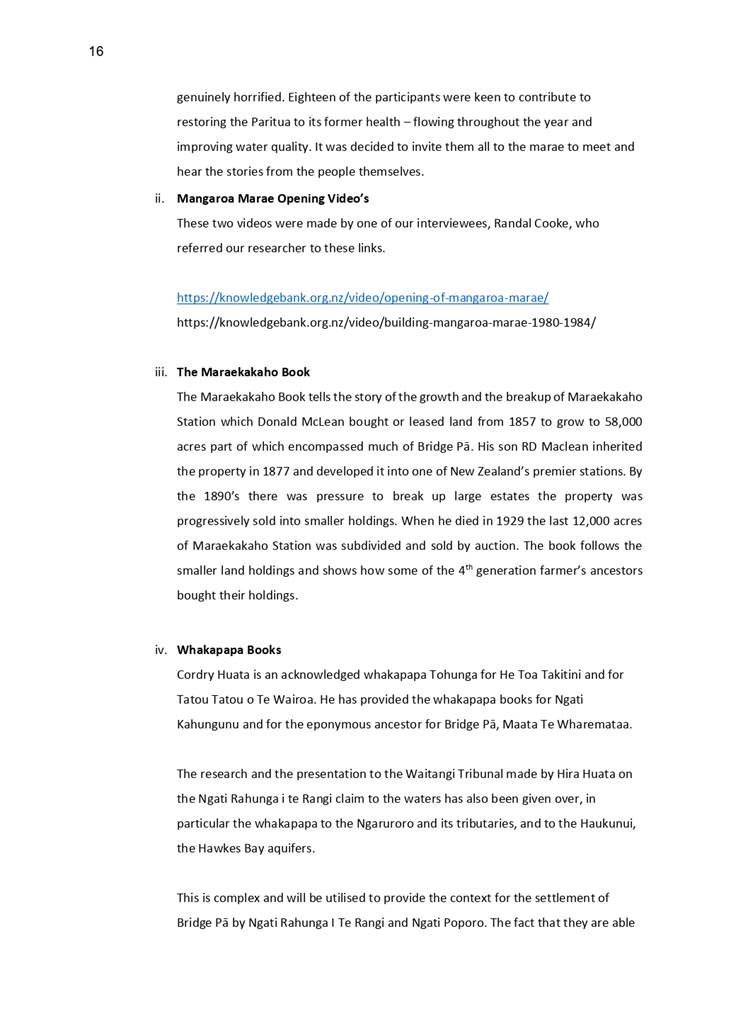
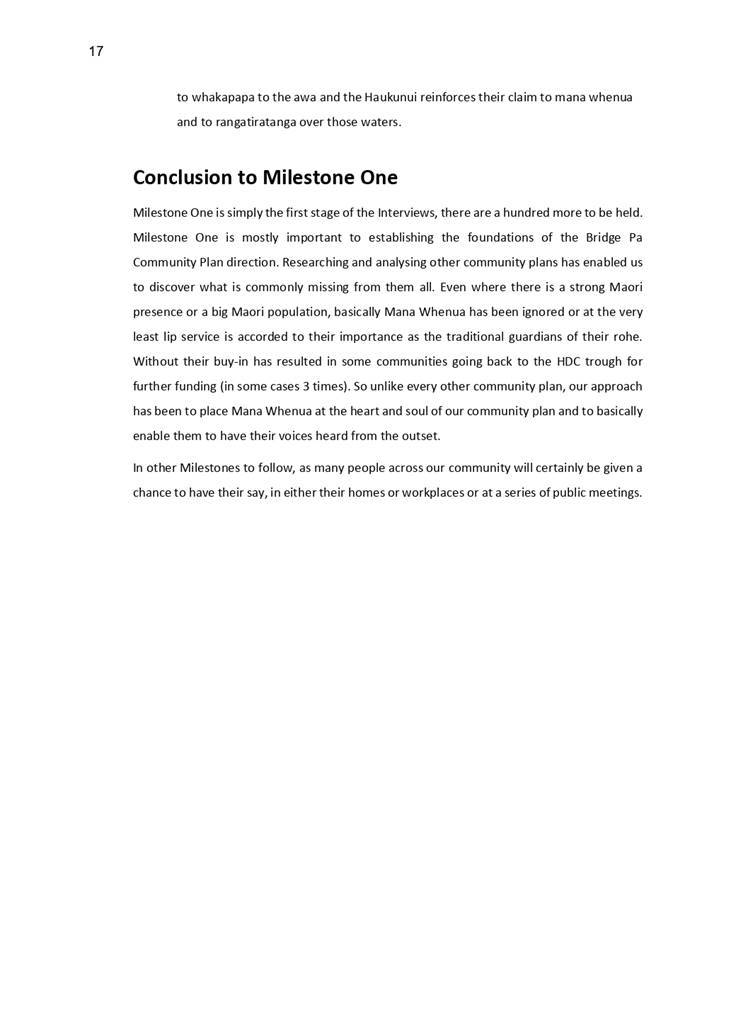
REPORT TO: HDC
- Māori Joint Committee
MEETING DATE: Wednesday 22 May
2019
FROM: Pou Ahurea Matua - Principal
Advisor: Relationships, Responsiveness and Heritage
Dr
James Graham
SUBJECT: Māori
Joint Committee Tangata Whenua [Replacement] Membership
1.0 SUMMARY
1.1 The purpose
of this report is:
· To engage the Māori Joint Committee in preliminary discussion on
the appropriate appointment process of tangata whenua members to the Committee
so that moving forward as the new triennium approaches, the Committee can make
a recommendation to Council on the appropriate process.
1.2 This
report arises from one of the tangata whenua seats on the Committee being
vacated by Shayne Walker at the start of 2019.
1.3 The
Council is required to give effect to the purpose of local government as
prescribed by Section 10 of the Local Government Act 2002. That purpose is to
enable democratic local decision-making and action by, and on behalf of,
communities
1.4 While this
decision is principally administrative and relates to Council’s
governance and decision-making arrangements in carrying out the purpose of
local government, in particular this decision addresses the intent to maintain
and improve opportunities for Māori to contribute to local government
decision-making processes, and to facilitate participation by Māori in
local authority decision-making processes.
1.5 This report
concludes by recommending that the Committee receive the report.
2.0 BACKGROUND
2.1 The current
Terms of Reference for the Joint Committee were adopted by the Council on 8
November 2016 (ie this was the reconvened date of the Inaugural Council meeting
which commenced on 26 October 2016). They reflect the provisions that were in
place for the previous triennium. The Council’s committee structure
established under the provisions of the Local Government Act 2002 and more
directly under the provisions of Schedule 7.
2.2 Essentially
the use of a committee structure is to enable governance decision-making to
occur in a timely and responsive manner so as to allow the business of the
Council to operate efficiently and effectively while ensuring democracy
principles are given appropriate cognisance.
2.3 In the case
of the HDC: Māori Joint Committee, the structure provides one avenue to
enable Māori input into the Council’s decision making process.
2.4 The
committee structures used by councils throughout New Zealand have many
variations reflecting the “local” flavour and preferences of the
communities the particular councils serve.
3.0 CURRENT
SITUATION
3.1 At the most
recent Committee meeting, the resignation of Shayne Walker was accepted meaning
that a vacancy existed that needed to be filled at some point; either now and
this late in the triennium, or later post the elections and early in the new
triennium.
3.2 At the meeting and the Council meeting that followed a couple of
weeks later, the Council resolved to ratify the HDC: Māori
Joint Committee recommendation and agreed to the appointment of tangata whenua
members, with voting rights to the Hastings District Council Standing
Committees. The following tangata whenua members were
appointed to the four Council Standing Committees from 28 March 2019:
|
Community
Development
|
Evelyn Ratima
|
|
Finance and
Risk
|
Ngaio Tiuka
|
|
Strategy, Planning and Partnerships
|
Tracee Te Huia
|
|
Works and
Services
|
Te Rangihau
Gilbert
|
3.3 Council
also recommended that the HDC: Māori Joint Committee review the current
Terms of Reference and Membership for the upcoming 2019-2022 triennium. The
current Terms of reference are attached (see Attachment 1).
4.0 OPTIONS
4.1 According
to the Terms of Reference, the current criteria stipulates that:
· 6 members from within the Māori Community are to be appointed
by the Council and Kaumātua, taking into account the “post
settlement environment” and Mātāwaka.
4.2 This is
essentially a matter for the Committee to consider within its understanding of
the role that it plays in the Councils decision-making framework.
4.3 With one
meeting to follow in August before the end of the triennium, the Committee
could consider and discuss this important issue today and looking forward,
charge officers with the task of preparing options to be presented at the
Committee’s August hui with the key issue to be navigated being:
· What is the appropriate appointment process to recommend to Council?
5.0 SIGNIFICANCE
AND ENGAGEMENT
5.1 This matter
is likely to be of some public interest, however seeking any further community
views is not considered necessary and this matter can be determined by Council and
kaumātua (as per the current Terms of Reference) after considering the
Significance and Engagement Policy for the following reasons:
· The fundamental democratic decision making process is not altering
consequentially from that which the community has endorsed;
· The making of Māori appointments would be consistent with
Council’s approach, and legislative intent to enhancing Māori
participation in decision making; and,
· The decision is consistent with the intent of Council’s
Māori Responsiveness Framework - Te Kura Nui.
|
6.0 RECOMMENDATIONS
AND REASONS
A) That
the report of the Pou Ahurea Matua - Principal Advisor: Relationships,
Responsiveness and Heritage titled “Māori Joint Committee
Tangata Whenua [Replacement] Membership” dated 22/05/2019
be received.
With the reason for this decision
being that the objective of the decision will contribute to meeting the
current and future needs of communities for local public services in a way
that is most cost-effective for households and business by improving Māori engagement in the Council’s governance
and decision-making processes.
|
Attachments:
|
1
|
HDC Maori Joint Committee proposed terms of
reference - 5 April 2017 - Resolved at Council meeting of 20 April 2017
|
CG-14-14-00020
|
|
|
HDC Maori Joint Committee proposed
terms of reference - 5 April 2017 - Resolved at Council meeting of 20 April
2017
|
Attachment 1
|

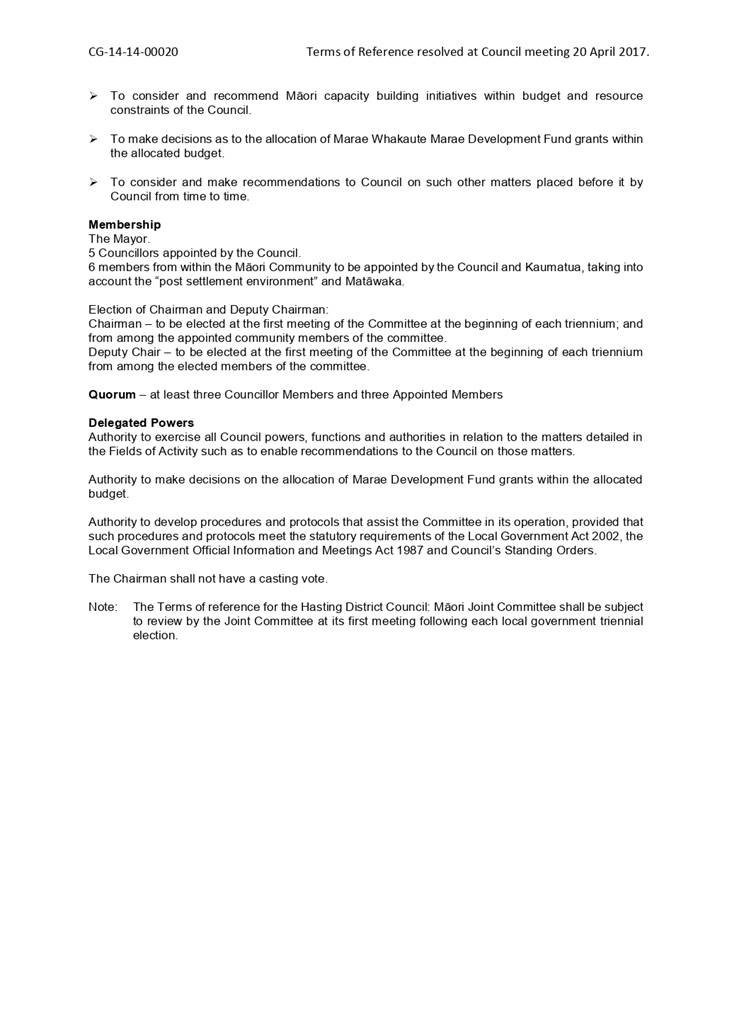
REPORT TO: HDC
- Māori Joint Committee
MEETING DATE: Wednesday 22 May
2019
FROM: Principal Advisor: District
Development
Mark
Clews
SUBJECT: Greater
Heretaunga/Ahuriri Freshwater Catchments -TANK Process and Draft Plan Change
1.0 SUMMARY
1.1 The
purpose of this report is to inform the Committee of the Council’s input
on a Draft Change to the Regional Resource Management Plan (RRMP) for land and
water management in the Greater Heretaunga/Ahuriri Freshwater catchments.
1.2 This
issue arises from a collaborative stakeholder engagement process run by the
Hawke’s Bay Regional Council (HBRC) to implement the 2014 National Policy
Statement for Freshwater Management (NPSFM) in the Tutaekurī, Ahuriri,
Ngaruroro and Karamū (TANK) catchments. Under the Resource Management Act
(RMA) the HBRC is required to consult with various statutory bodies including
the Territorial Authorities (and Iwi Authorities) in its region before publicly
notifying a proposed plan change. HBRC released a pre-consultation draft in
February for this purpose and to consult informally with other stakeholders.
1.3 The
Council is required to give effect to the purpose of local government as
prescribed by Section 10 of the Local Government Act 2002. That purpose is to
meet the current and future needs of communities for good quality local
infrastructure, local public services, and performance of regulatory functions
in a way that is most cost–effective for households and businesses. Good
quality means infrastructure, services and performance that are efficient,
effective and appropriate to present and anticipated future circumstances.
1.4 The
objective of this decision relevant to the purpose of Local Government is the
performance of the HBRC’s regulatory functions under the Resource
Management Act and the National Policy Statement on Freshwater Management as it
affects this Council’s interest as a stakeholder. This includes the
provision of good quality water and stormwater services, and the potential
impacts the regulatory outcomes may have on the District’s economic
social and environmental wellbeing.
1.5 The
subject matter of the report is also directly related to the Council specific
objectives in the table below.
1.6
|
Local
Infrastructure
|
· Infrastructure
supporting economic growth
· Industrial
development opportunities
· Resilience
to hazards and shocks
· Sustainable
use of land & water resources
· Healthy
drinking water and sanitary services
|
|
Local
Services
|
· Supporting
and attracting business
· Building a
resilient and job rich local economy
· A
community which wastes less
|
|
Regulatory
Functions
|
· Healthy waterways
|
1.7 This
report concludes by recommending that the report be received and the Committee
notes the submissions to the Regional Planning Committee on the matters raised
in this report made by the Chief Executive under delegated authority.
2.0 BACKGROUND
2.1 Implementation
of the NPSFM is largely the HBRC’s responsibility with the primary policy
instrument being the Regional Resource Management Plan (RRMP). The NPSFM
requires regional councils to set freshwater objectives, water allocation limits
and water quality targets for every water body in their region, including
aquifers and wetlands in order to maintain and improve water quality.
2.2 In
this case the Regional Council adopted a combined catchment approach to reflect
the interconnectedness of the Heretaunga Plains aquifer and the surface water
resources in these TANK catchments as shown in Figure 1 below.
2.3 85%
of Hawkes Bay people live, work and play within this catchment footprint. A
range of community held and ecosystem values rely on adequate water levels and
flows to be maintained within water bodies, but the community also values water
for a range of abstractive uses such as domestic water supply, irrigation for a
range of purposes including food and wine production; māra kai, food
processing, stock watering and municipal supply.
2.4 Ngāti
Kahungunu regard water as a taonga. This also aligns with Council’s own
philosophy, but access to water is also a critical component in realising the
productive capacity of the versatile Heretaunga Plains soils for food and fibre
production.
2.5 The
prosperity of the Region’s rural and urban populations is dependent upon
the land based primary industries and some significant processing industries
rely on a secure supply of primary produce and access to reliable and clean
water for processing. It is important therefore that the right balance between
protection and use is found and agreed upon.
Figure 1 TANK Catchments

2.6 In
view of this the HBRC elected to use a stakeholder based collaborative planning
exercise to determine how water bodies within the TANK catchments should be
managed to meet the diverse interests and needs of the community. The TANK
group was established in 2012 and comprises over 30 groups and organisations
representing a spectrum of water users, environmental interests,
recreationalists and Tangata whenua/mana whenua groups. The process included
Hastings District and Napier City Council officer participation. Industrial
abstractors reliant on their own bores instead of municipal supply were not
however, specifically represented.
2.7 Council
was represented on the TANK Group by the Principal Advisor, District
Development and since the middle of 2017 Council’s Group Manager Asset
Management has also attended meetings to ensure Council’s roles and
interests as a territorial authority as set out below are represented:
· Abstracting
groundwater for municipal supply and discharging urban stormwater to freshwater
receiving bodies
· Having
land use planning responsibilities under the RMA that affects freshwater
· Advocating
for district rural and urban dwellers economic and social wellbeing where this
is dependent upon water quality and quantity.
3.0 CURRENT
SITUATION
3.1 The
TANK Collaborative process has now drawn to a close and a Draft Plan Change was
presented to the Regional Planning Committee of the HBRC on 15 August 2018.
This was hastened by the application for a Water Conservation Order (WCO) for
the Ngaruroro River. The Special Tribunal appointed by the Minister for the
Environment to hear and determine it, deferred temporarily the hearing on the
lower reaches, to allow the TANK process to conclude so that any consensus
reached could be considered in their deliberations. The Tribunal
completed it hearings on 3 April and are now considering their recommendation
to the Minsters of Conservation and the Environment.
3.2 Notwithstanding
the WCO, the role of the TANK Collaborative Stakeholder Group was to provide
the HBRC’s Regional Planning Committee (RPC) with consensus
recommendations regarding objectives, policies and methods, including rules,
for a new chapter of the RRMP. The RPC had previously agreed to have particular
regard to any TANK consensus outcome, if one emerges.
3.3 The
RPC completed its initial deliberations on the Plan Change in December last
year and released a draft for informal pre-notification consultation in
February. The HBRC is required under the RMA to consult specifically with the
Territorial Authorities within its region during the preparation of any
proposed plan change and requested the Council’s feedback on the draft
change by 31 March 2019.
3.4 In
considering it’s feedback Council needed to be cognisant that the plan is
required to give effect to national and community values for freshwater, but
that compulsory values have been set by the NPSFM for ecosystem health and
human health for recreation, which is an important direction to be borne in
mind at every step in the process.
3.5 The
NPSFM requires that regional councils set limits and targets, include measures
that prevent or reduce over-allocation, both in relation to water quantity and
the capacity of the environment to assimilate diffuse discharges from land use
on water quality. Over-allocation means that the ecosystem needs of the water
body are not being met and/or that abstractive users are subject to uncertain
security of supply in the case of water quantity.
3.6 Once
sustainable limits have been set to protect instream values, the plan must
manage the allocation and re-allocation of the water available for abstraction
and the application of nutrients to land in an equitable way among a wide range
of water users. It should also enable users to manage the use of allocable
water in efficient and cost effective ways so that the allocation can generate
the most benefit for the community (without the HBRC necessarily picking
winners).
4.0 Councils
Consideration
4.1 Council
has had two workshops on the Draft plan change and possible responses to the
challenges for water allocation and management it represents or poses for the
council and community. Overview and Discussion Papers prepared for those
workshops are available for members by way of further elaboration if desired,
but this report covers the Council’s response at a higher level.
4.2 The
Council’s concerns with the Plan Change relate to the provisions
concerning water quantity limits and allocation provisions, rather than quality
concerns (where there is largely a consensus of views), both in terms of
irrigation demand on the Heretaunga Plains and in terms of its own core
responsibilities for municipal water supply. This is where the major economic
limitations are likely to bite, but with less certain and demonstrable benefits
for instream fauna and flora, given our naturally occurring summer/winter
weather extremes.
4.3 The
Draft Plan Change will cap allocation to existing use in the first instance, subsequently
claw back over-allocation where that exists, and only provide for the
offsetting of existing stream depletion effects through storage and/or aquifer
fed stream flow enhancement, at least initially. This will leave no room for
growth, or intensification of land based production and associated processing industries.
4.4 Allocation
for municipal supply to deal with urban growth will also likely be limited,
meaning this will not be a ready source of alternative water for industrial
processing use in lieu of new bores, or increased takes from existing bores. Indeed,
it appears at present that municipal needs associated with growth will also
potentially need to be met through storage with potentially greater pragmatic
and cost difficulties.
4.5 Until
the re-allocation to existing use is completed and a review of sustainable
allocation completed alongside feasibility studies for water storage and flow
enhancement, there simply will not be any available water for intensification
or new use. This could take ten years to complete.
4.6 While
these are significant issues for the Council it needs to be recognised that
there is now a new reality around freshwater resources nationally and within
the Heretaunga Catchments as a result of:
· Greater
National Direction on freshwater management, urban development and protection
of versatile soils.
· Heightened
public awareness and expectations on quality
· Groundwater
/surface water connectivity in the TANK catchments is much greater than
previously understood
· The
scale of potential over-allocation versus actual allocation is better
understood in the TANK catchments
· Greater
understanding of abstraction effects on groundwater and surface water levels in
the TANK Catchments
· Increased
innovation in water use and allocation management
· Integration
of 3 waters thinking and Government Review
4.7 These
are longer term enduring changes that present challenges which will not be met
by taking a short or even medium term view. These are fundamental shifts that
cannot be satisfactorily addressed through a modified business as usual
approach. Not only do we need to change how we view and use water resources, we
also need to review what represents desirable economic development/growth when
it involves the use of scarce resources such as water and versatile soils of
the Heretaunga Plains. Increasingly decisions about land and water will need to
be made against backdrop the government’s desire to move New Zealand
towards a low carbon economy as signalled by through the Carbon Zero Bill.
4.8 Accordingly
it was the officers’ advice to the Council that it should take a positive,
rather than a combative, approach to responding to the plan change.
Specifically it should be seeking changes to the plan change that will better
enable the Council to take a longer term strategic approach that works within
the limitations of the current water resources, and to facilitate growth
through investment in augmentation, innovation and excellence in water
management, as well as leading a sea change in community awareness and
behaviour.
4.9 The
Council has therefore endorsed officers commencing work on a fifty year
intergenerational water strategy that is underpinned by the following (but
still draft) high level principles that have been conceptualised through
engagement to date with local landscape cultural narratives, dialogue with mana
whenua / tangata whenua, and relevant literature:
· Kaitiakitanga - Intergenerational
- sustainable growth through excellent leadership and
guardianship - providing enough for now while creating room for the
future. Smart growth, innovation and water excellence to facilitate
population growth and prosperity.
· Toitū te Taiao – Sustainable
– economic objectives and environmental outcomes are complimentary -
economy within sustainable environmental limits and approaches, rather than
holding to current levels. People/ animals/environment share impacts and
benefits of life-giving waters.
· Te Ararau – Adaptable -
resilience, multiple pathways – flexibility
within parameters to change and evolve to new opportunities beyond our current
practice. Potential infrastructural investment in sustainable resource
use to meet growth objectives.
· Oranga Hapori – Societal -
community wellbeing – HDC takes a lead role in
working with others, taking our people with us, whilst recognising different
perspectives to improve water availability for our community.
· Mana Taurite – Equitable
-accessibility, affordability and equity for our
community as a basic right embodying needs before wants, fairness for all,
cultural recognition & redress
4.10 On
this basis a multi-disciplinary team of officers and consultants prepared some
suggested comments on the draft plan change for a suggested submission to the
HBRC. This was ultimately endorsed by the Council as its formal comments as set
out in Attachment 1. They take the approach that there are provisions
that should be supported, but also provisions that Council holds concerns about
that require amendment if they are to enable the Council and community to
better rise to the challenges of growing within the limits of the water
resource. In summary the suggestions seek amendments to:
· Recognise the nature of urban growth demands and nature and
frequency of changes are different to other sectors and therefore require
different management tools.
· Recognise HPUDS as minimum demand for planning for municipal growth,
but that changes are inevitable and need to be responded to positive.
· Acknowledge it is reasonable to reserve some unused allocation as a
means of enabling for independent industrial/community growth and use of water
on versatile soil and in addition to municipal growth.
· Greater clarity and flexibility around activity status for municipal
takes
· Stronger commitment to investigate increasing or decreasing
groundwater abstraction with mitigation to establish a sustainable
equilibrium.
· Greater flexibility for transfers of allocated water as a means of
enabling opportunity provided they do not result in an increase in water
abstraction, including for and between municipal use.
· Provide for TAs to manage some allocations on a collective basis for
urban activities not supplied from municipal as a means of enabling opportunity
while managing water use.
· Greater clarity and flexibility in relation to stormwater
performance.
5.0 PREFERRED
OPTION AND REASONS
In adopting the
comments on the Draft Plan Change the Council also endorsed officers commencing
work on a 50 year intergenerational water management strategy. The purpose of
the strategy is to facilitate economic and urban growth within acknowledged
limits on the available fresh water resources. It is anticipated that progress
on the strategy preparation will be reported to the Joint Committee at regular
intervals for input.
|
6.0 RECOMMENDATIONS
AND REASONS
A) That
the report of the Principal Advisor: District Development titled “Greater
Heretaunga/Ahuriri Freshwater Catchments -TANK Process and Draft Plan Change
B) That
the Committee note that pursuant to section 3 1) c) of the Resource
Management Act Council the Chief Executive acting under delegated authority
made comments to the Hawke’s Bay Regional Council on its Draft Plan
Change 9 to the Regional Resource Management Plan as set out in Attachment 1
(EXT-11-02-19-874) to the report in (A) above.
C) That the Committee notes that the Council endorsed officers
commencing work on an intergeneration water strategy to help facilitate
economic and urban growth within the limitations of current and future
freshwater resources of the Heretaunga Plains.
With the
reasons for this decision being:
That the
objective of the decision will contribute to meeting the current and future
needs of communities for good quality local infrastructure performance of
regulatory functions in a way that is most cost-effective for households and
business by:
· Influencing the exercise of the
HBRC’s statutory functions under the Resource Management Act and the
National Policy Statement on Freshwater Management as it affects this
Council’s interest as a stakeholder; and
· This
includes the provision of good quality water and stormwater services, and the
potential impacts the regulatory outcomes may have on the District’s
economic social and environmental wellbeing.
|
Attachments:
|
1
|
Hastings District Council comments on
Pre-notification draft of Change 9 to the RRMP TANK Catchments Freshwater
management
|
EXT-11-02-19-874
|
|
|
Hastings District Council comments on
Pre-notification draft of Change 9 to the RRMP TANK Catchments Freshwater
management
|
Attachment 1
|

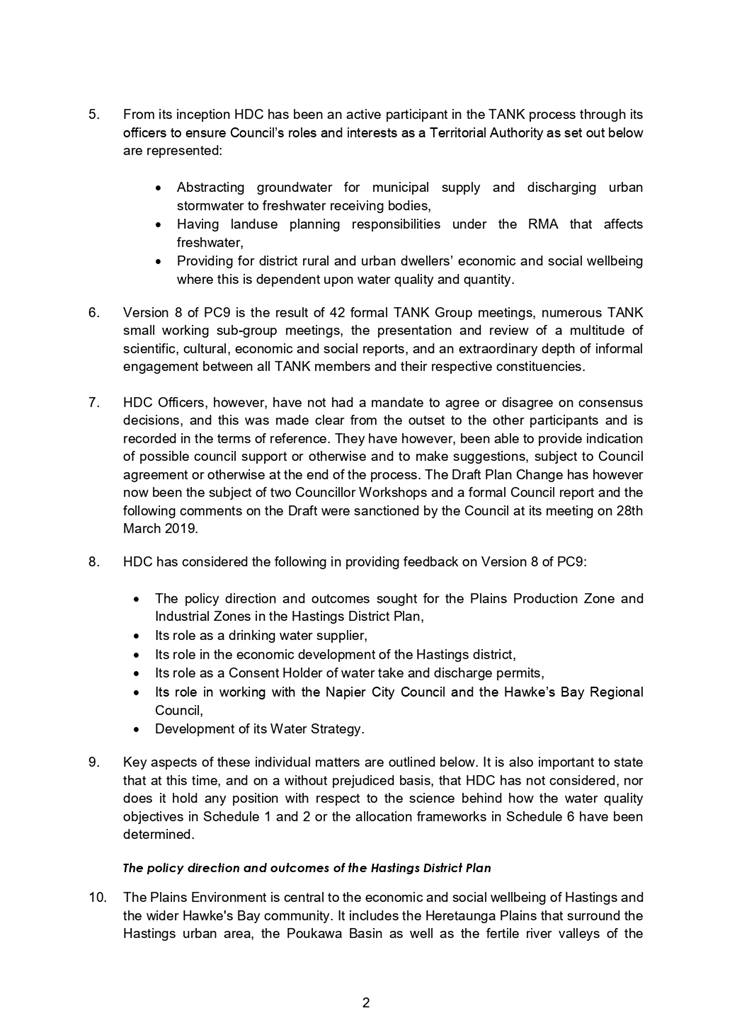

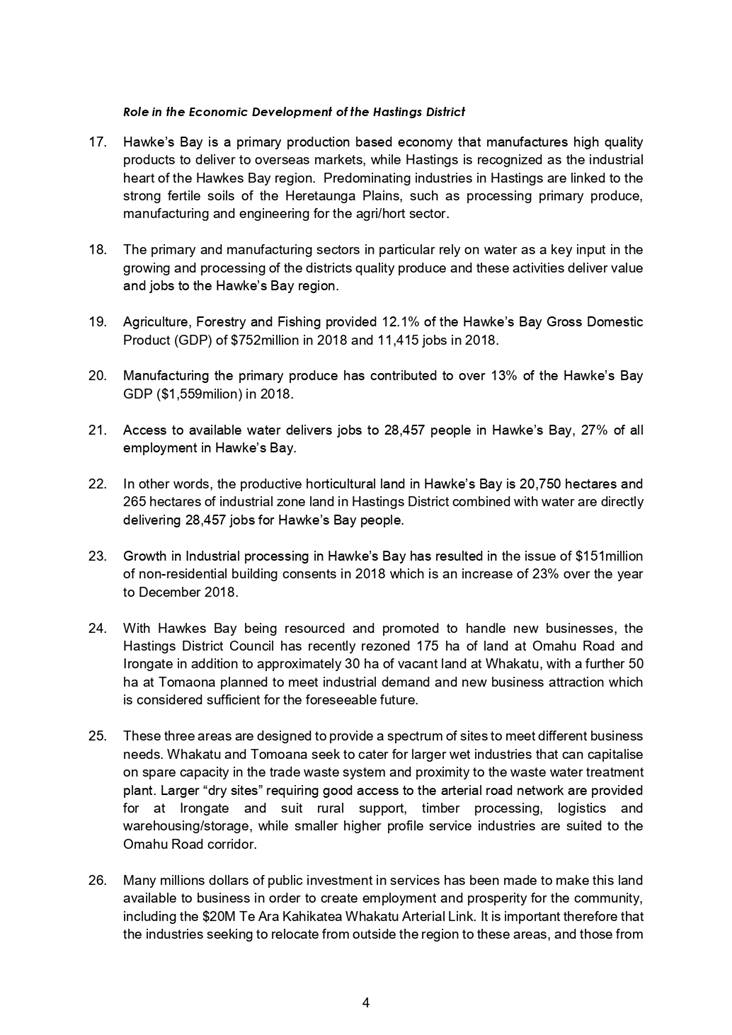
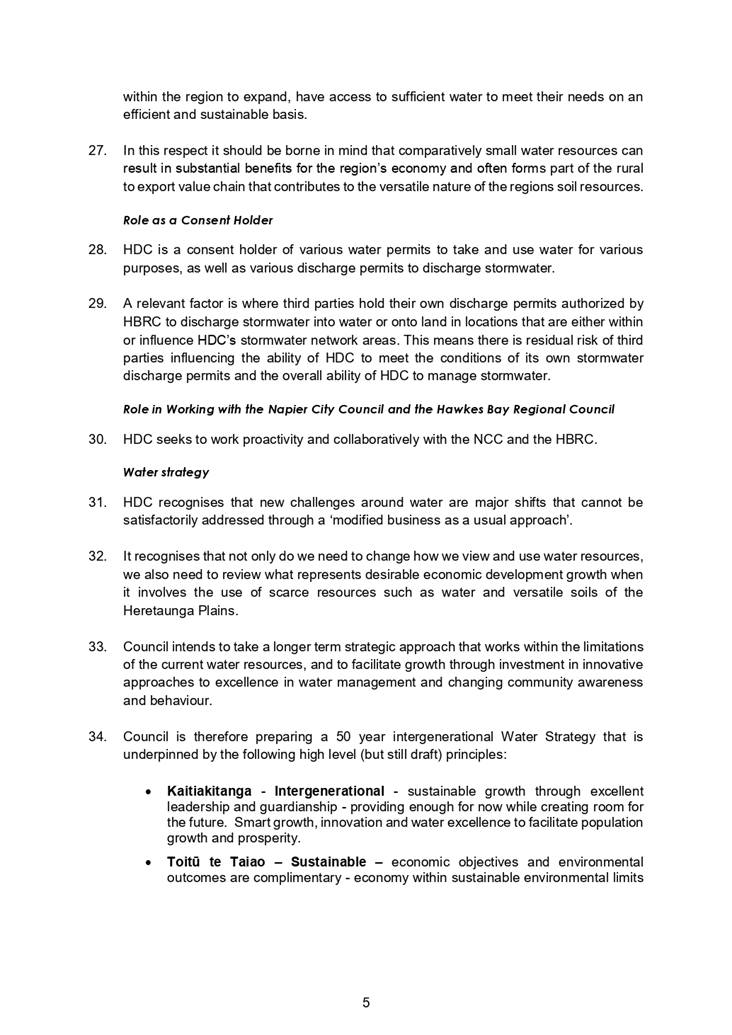
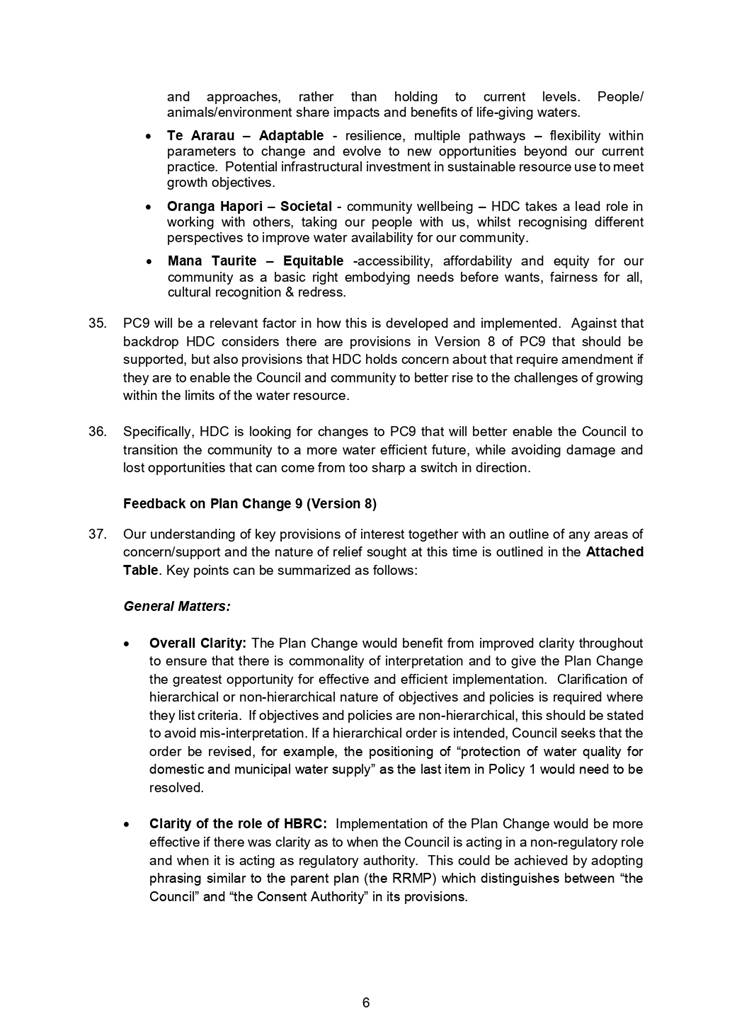



|
Hastings District Council comments on
Pre-notification draft of Change 9 to the RRMP TANK Catchments Freshwater
management
|
Attachment 1
|
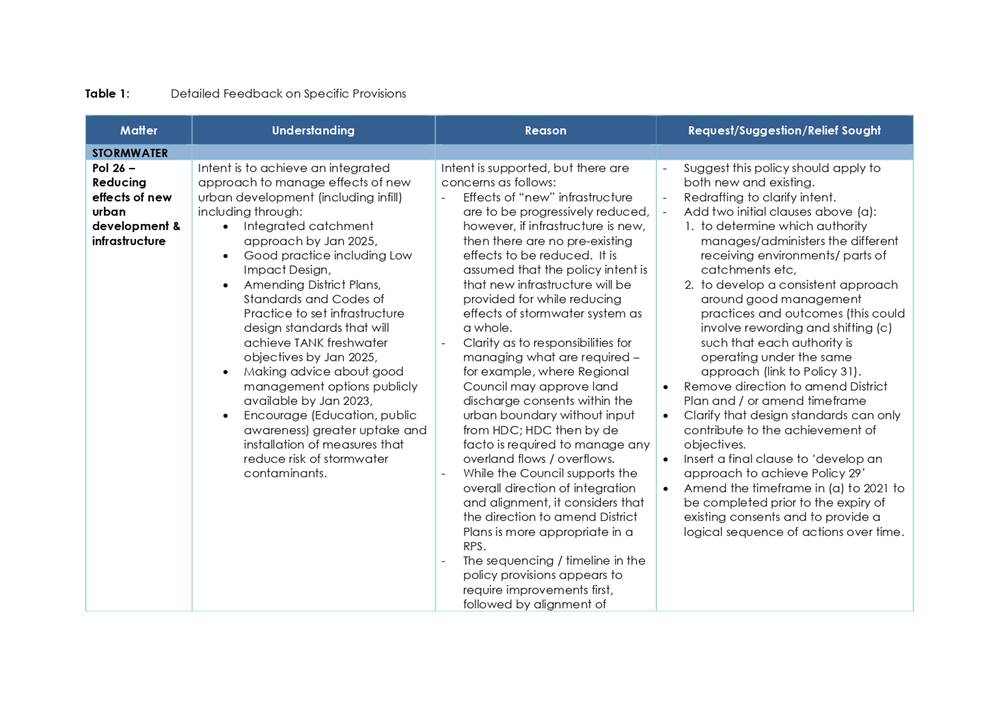
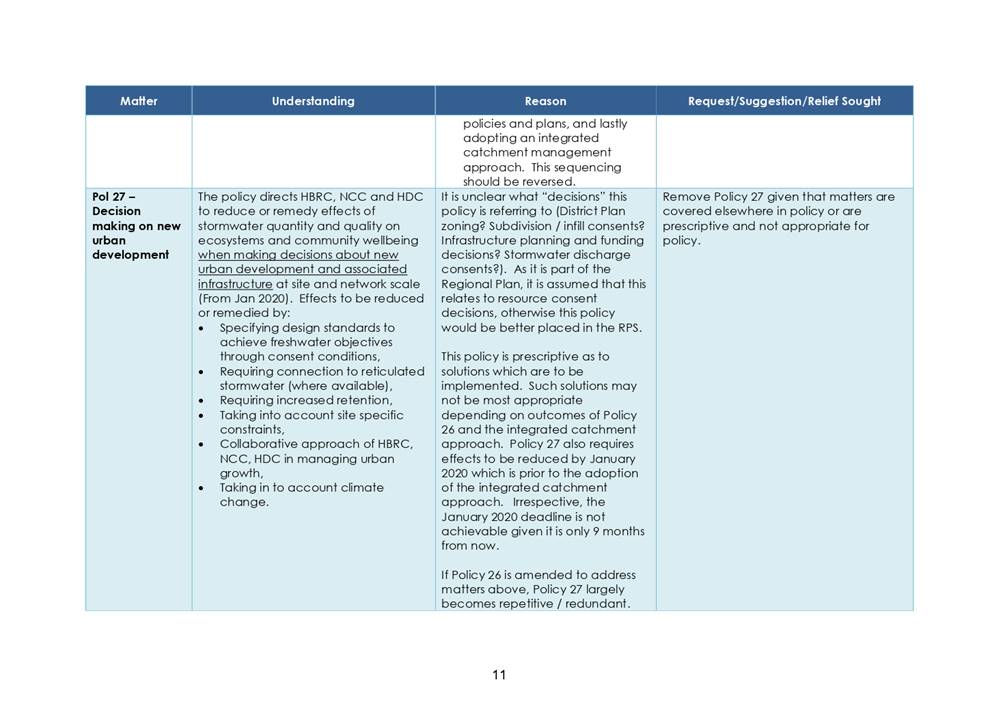
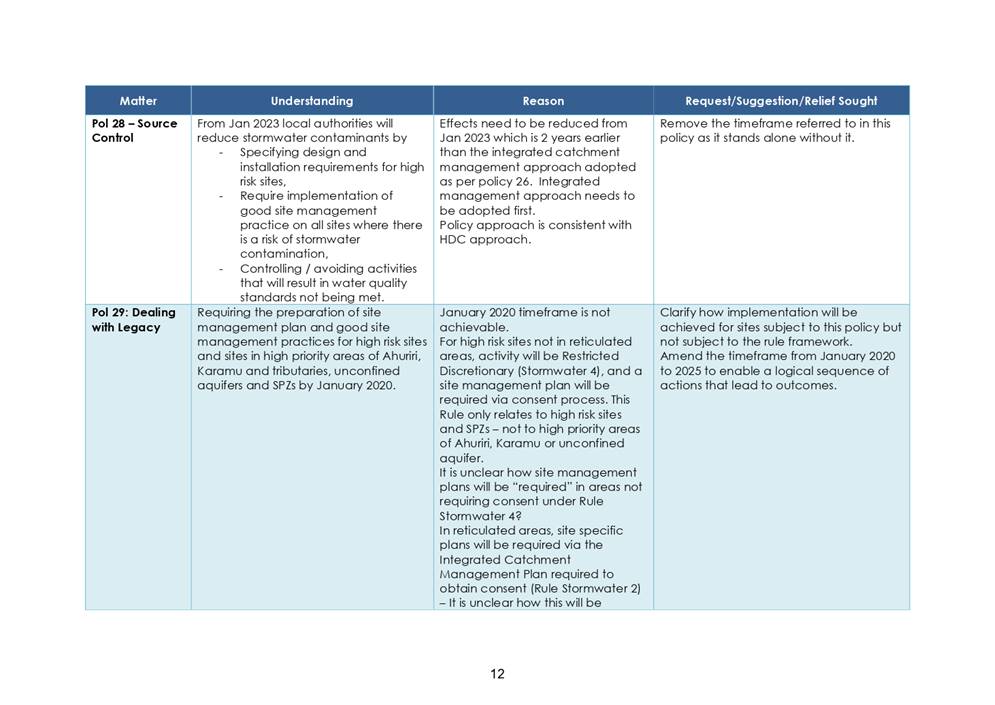

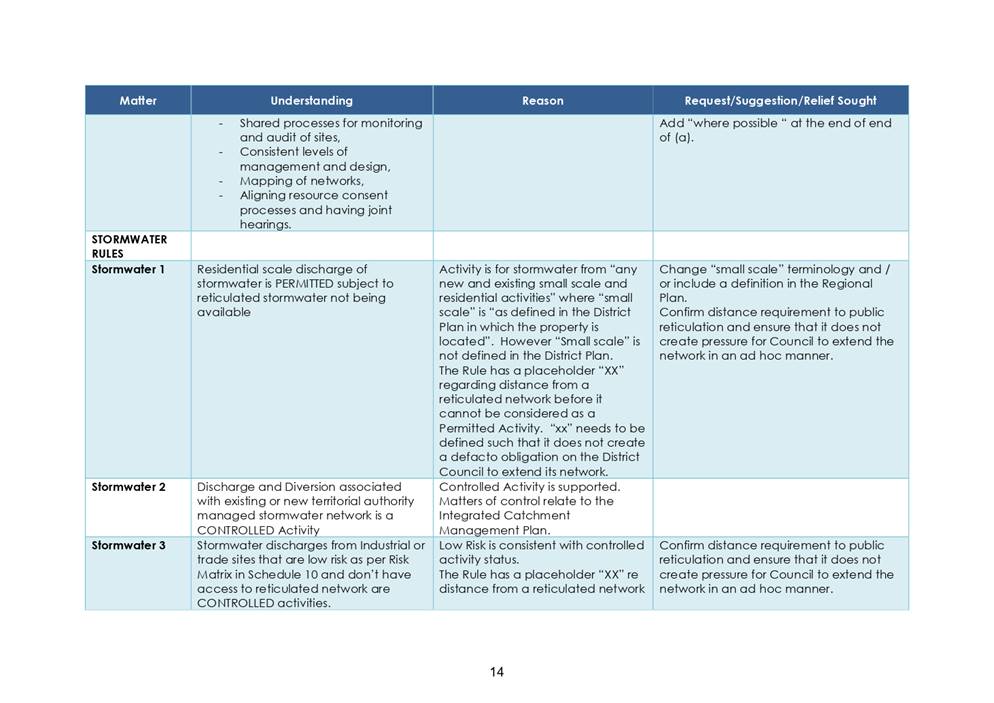
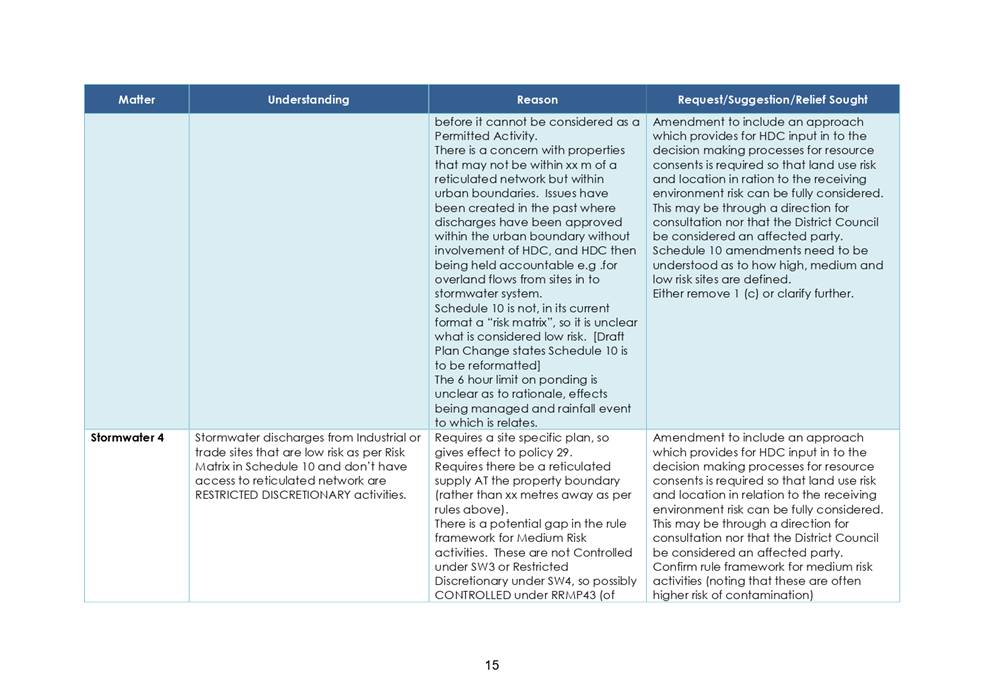

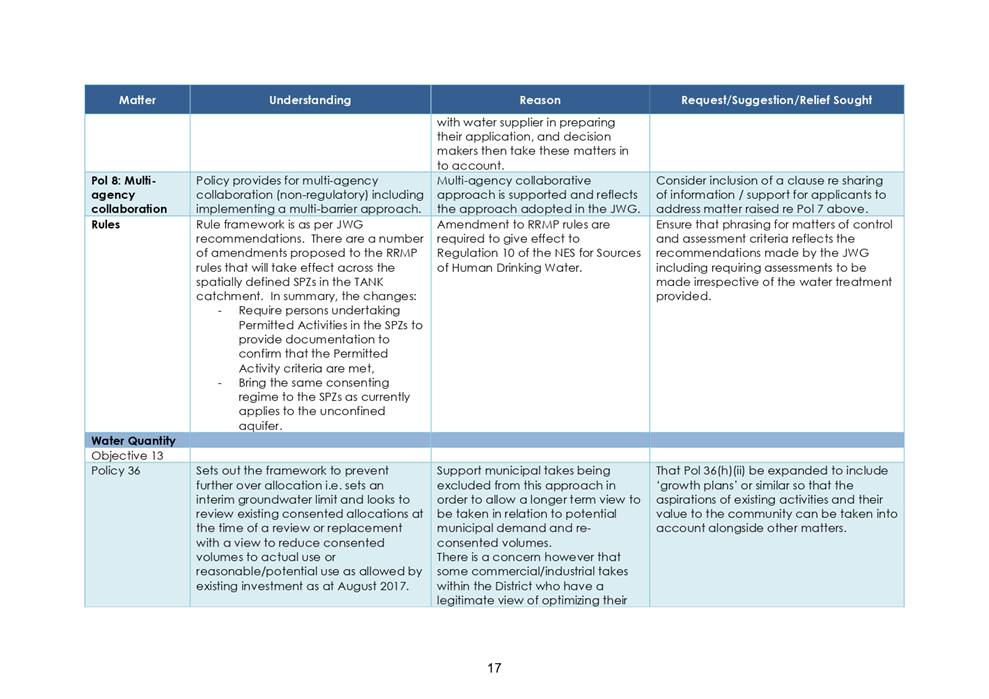
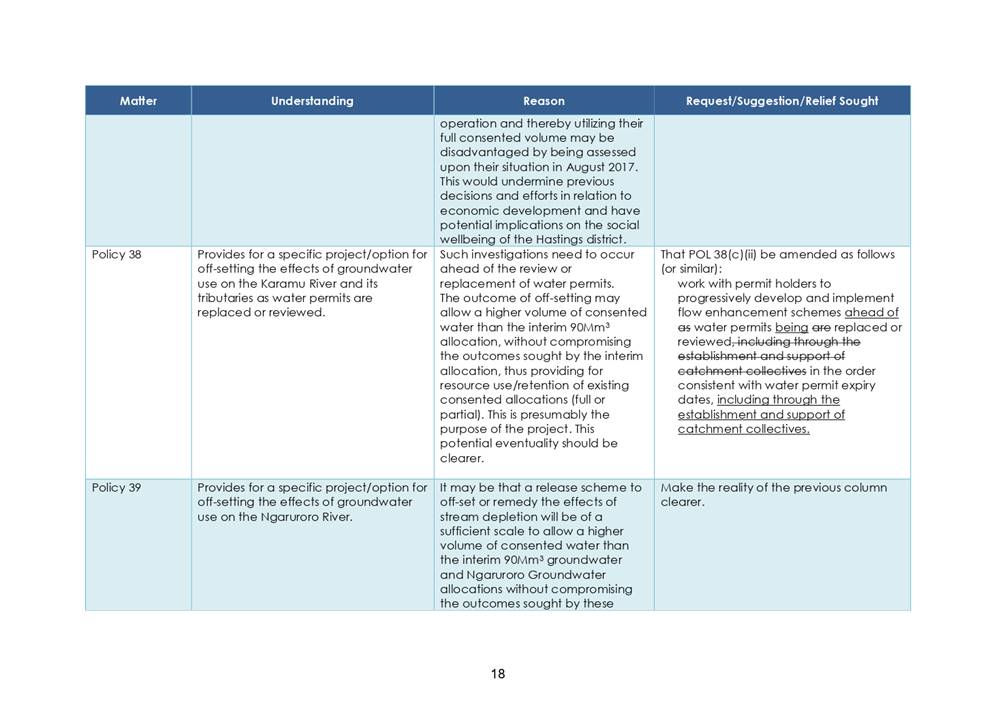
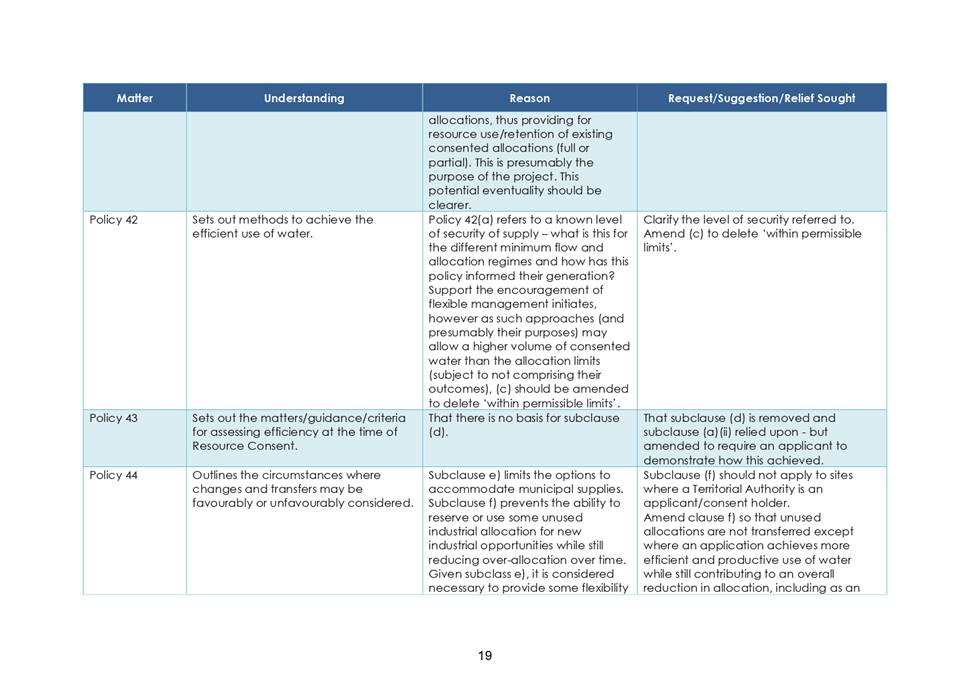

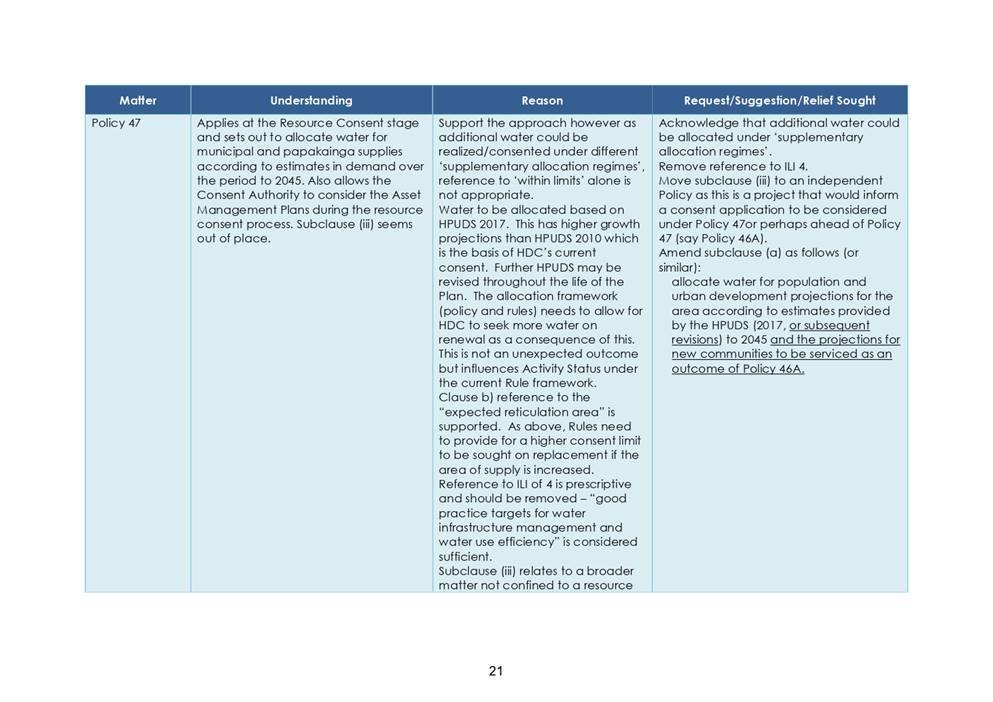
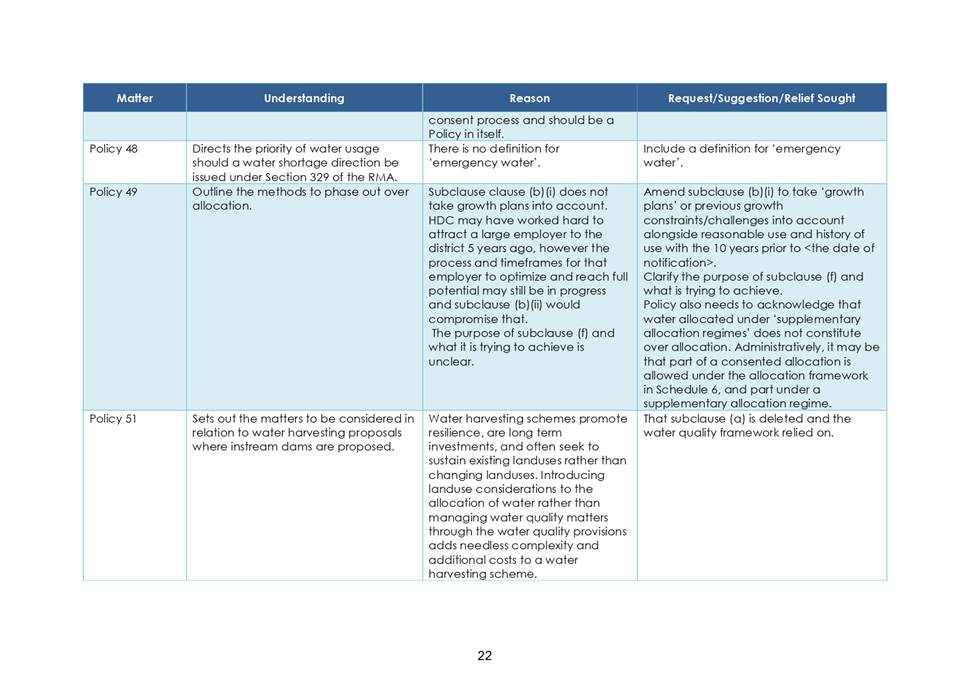
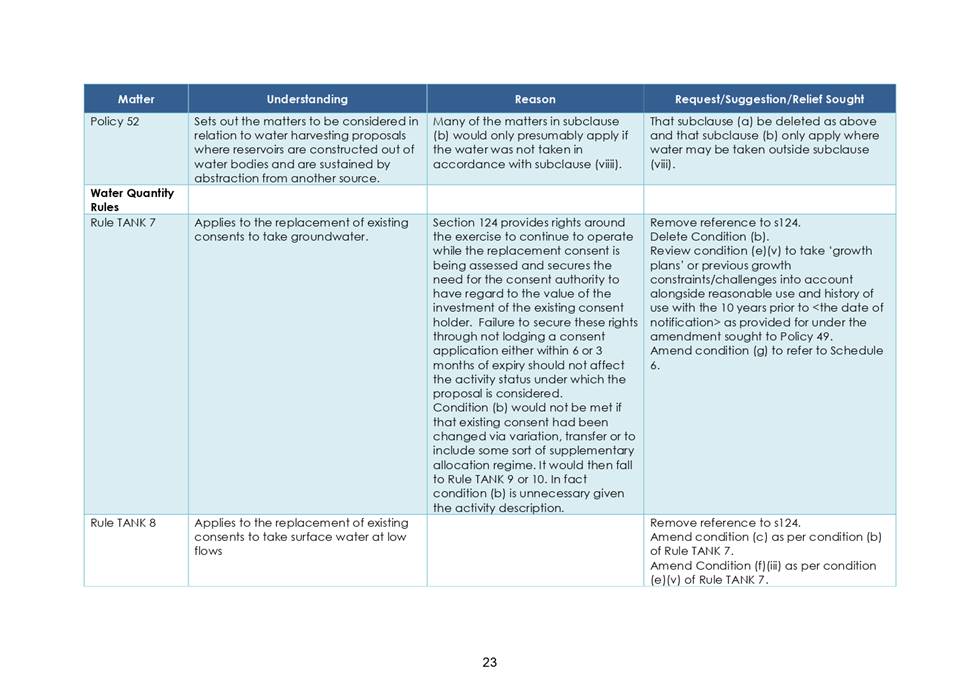
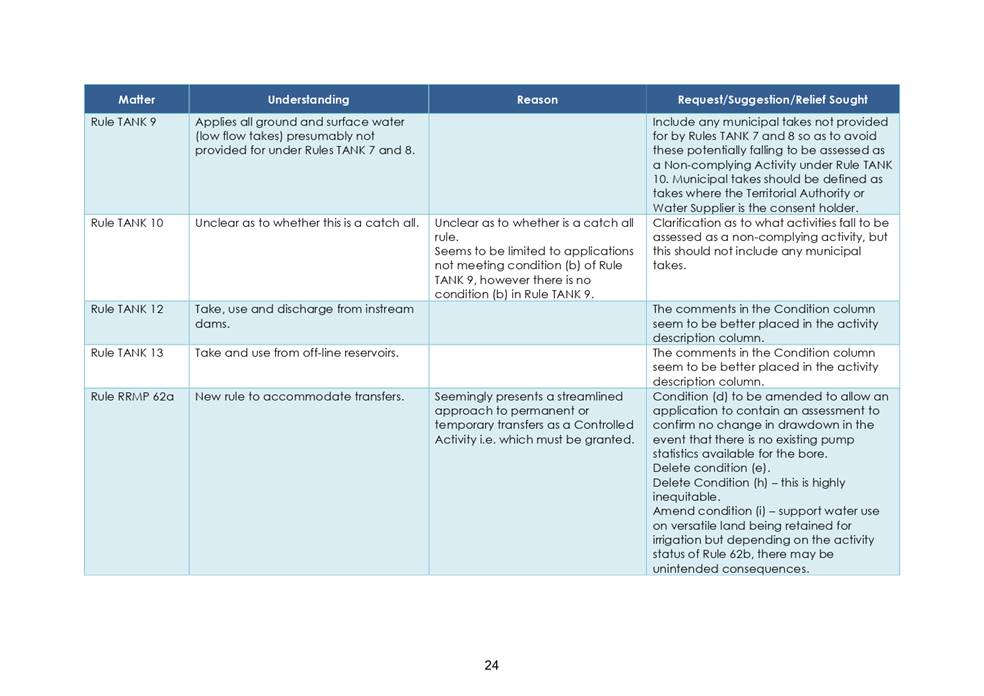
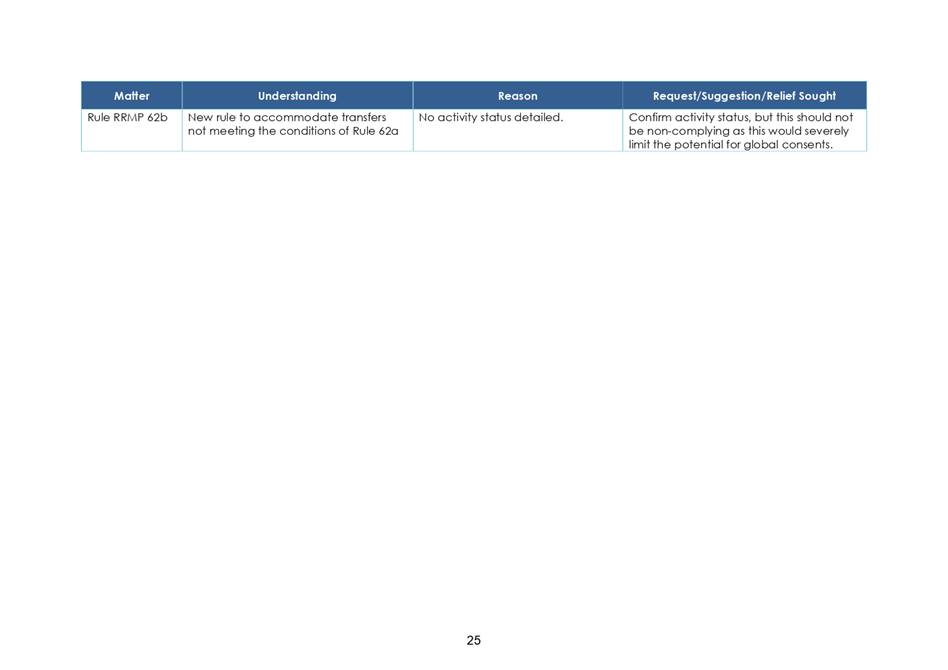
 Hastings District
Council
Hastings District
Council



































































